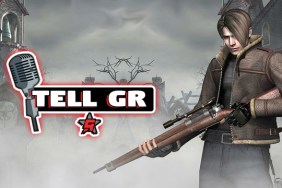The title isn’t talking about Squaresoft, is it?
One of the running inside jokes in the JRPG world (and no, its people are not turn-based) is that Squaresoft hasn’t been able to produce a stellar game since it has become Square Enix. Of course, when anyone tries to tell me that joke, I like to direct them to a box for The World Ends With You before I shove some pins down their throat and laugh. But like most wonderfully awful humor based on sweeping generalizations, there is a modicum of truth (albeit a stinging one) in it.
[image1]Square Enix seems to have its mind bent on twisting the traditional turn-based JRPG which it has so masterfully developed in its celebrated past into a mutant version of itself – whether it be the MMO Final Fantasy XI, the MMO-inspired RPG Final Fantasy XII, the real-time RPG Infinite Undiscovery, the first-person sword-swinging rail-hack-n-slasher Dragon Quest Swords, or the squad-based strategy RPG The Last Remnant. But for all the over-designed complexity that is thrown in from every which angle, it’s actually just another long and easy adventure, which begs the question as to why it’s so complicated in the first place.
The Last Remnant revolves around the rambunctious adventures of Rush Sykes, the only son of the famous Sykes Remnant scientists, and his search of his little sister Irina, who has been kidnapped right out of his hands by a mysterious man wielding dark magical powers and commanding demonic beasts. Okay, seriously, Square-Enix really has to stop it with protagonists being sword-wielding, prepubescent, twinkie boytoys with emo-cupcake hairdos trying to rescue a cheerful, optimistic girl who holds a secret power deep inside her heart that she… doesn’t… understand… And she’s only 14!!! *heavy gasp*
Rush is the kind of person who, when seeing a figure that looks like his missing sister, will, befitting his name, dash towards it with blind faith, even if that means running through a raging battle between thousands of bloodied soldiers. And who is then surprised when he finds that the figure that’s slaying enemies with her deadly swordplay is not his skirt-wearing, flower-holding 14-year old sister, but the stern, 41-year old, General of Athlum Emma Honeywell. Honestly, his only legitimate excuse is if he’s a Dynasty Warriors fanboy; then and only then, will I feel sorry… very sorry.
His brashness leads him to be taken under the wing of Athlum and all of the political intrigue that comes with it – territorial disputes, political power plays, and unspoken racial tensions between the “why aren’t they just called humans?” Mitra; the four-armed, cat-like, long-lived Sovani; the heavyweight, long-necked, scaled Yama; and the pint-sized, flappy-eared, toad-like Gsiti. Eventually, Rush is wrapped in a conspiracy surrounding Remnants, large relics that destroy the balance of the world and call forth evil monsters unless someone has enough power to bind them, and The Conqueror, who you know is badass by his long, white Sephiroth-esque hair and his red and black long-sleeved vest that exposes his chest and six-pack abs, and probably if he could, his manhood.
[image2]Despite the richness of the world and its inhabitants, however, the relationships between the main characters are not as interesting as their appearances. This isn’t to say that they don’t have quirks, a troubled past, or some gut-wrenching secret they’ve been hiding. It is to say that their connections to one another are not quite as layered and intricate, anything beyond a simple soldier-king, brother-sister, son-father, good guy-bad guy bond. Meaning and depth can’t be filled with mere threads of interest.
Another reason there is a disconnect between characters is the squad-based combat system which minimizes their abilities to that of run-of-the-mill units. The Four Generals of Athlum, in particular the four-armed, four-sword-wielding, 200-year-old sovani Torgal, might sound like they would tear you up in seconds, but they’re not much more effective than a basic soldier.
Describing how the turn-based, squad-based RPG strategy combat system works is difficult to put into words, but that probably tells you a little about how unnecessarily complex it is. Your party of leaders (main characters or hired leaders) and standard soldier units can be grouped into unions, gaining benefits such as a much higher pool of shared hit points, a higher regeneration rate of AP skill points, formation bonuses, and better overall stats. The tutorial for forming unions doesn’t really explain things well, but it’s obvious that having full five-member unions with an extremely high HP level is best.
Essentially, unions act as single characters in battle, fighting against enemy unions in one-on-one altercations, with some additional damage dealt for strength in numbers – that is, two-unions-on-one, three-unions-on-one, and even four-unions-on-one. This might seem like a great system that inspires teamwork and it does to an extent, but unions act more like dense melting pots, five intelligent people who come together to form one incredibly strong but incredibly stupid person. (I’m trying hard not to make a Power Rangers joke.)
[image3]Individual units within a union can’t be given separate orders – everyone has to attack at the same time, defend at the same time, use magic arts at the same time, and so on and so forth (at the same time). Some orders allow some characters to attack while others heal, but it feels counterintuitive that you can’t just order each unit in a union to perform specific tasks. Why can’t you tell your high-offense units to attack, your high-magic users to disrupt an enemy union in the distance, your female healer to restore your wounded union members, while high-defense units defend her? I’ve heard of groupthink, but this takes it a bit too far.
For all the strategy that is supposedly involved, battles are extremely easy. This doesn’t mean that you won’t die during boss battles or that there are a few battles that won’t require some thought. Still, death usually comes only because either your unions are inflicted with a fatal status effect which you can’t remedy, or you’re clearly facing an enemy that is far beyond your league and you can’t escape because there is no escape command. (In that case, you will learn to save time by going back to the Xbox 360 dashboard and reloading your last save.)
For other encounters, all you have to do is ensure that your unions have high HP potential and that you select the command that uses up the most AP since it regenerates so darn fast. Being quick with your fingers during quick-time events that occur in the midst of battle helps to speed battles up and keep your attention, but its intensity is almost completely blunted by several things: your entire party fully recovers its HP after each battle, you can save nearly anywhere at any time, and your protagonist’s time-slowing “Timeshift” ability gives you near full control over which battles you want to fight or avoid.
You don’t even have to care for your party members, since their skills and stats automatically improve after each battle (characters don’t even have “levels”, per se) and you can’t replace their equipment with any better equipment you find. Moreover, it’s almost pointless to upgrade your equipment since your weapons and armor mean little compared to the collective strength of your other ten or more party members. All they will ask for is some loot every once in a while, but you’ll usually be swimming in so much loot that it’s an easy choice.
[image4]That said, don’t be lured into the upgrading system, which requires you to find specific loot either from battle or through your companion Diggs who digs (what gave it away?) out treasure at special sparkly points on a map. It’s just a poor way of pushing you toward revisiting dungeons over and over again just to look for some special timber or shiny fur, which is unnecessary not only because normal weapons are good enough, but because the game doesn’t need to be longer than it already is.
As you might expect from a Square Enix adventure that spans two discs, the music and art production is staggering on a level that rivals the best that RPGs have to offer. The orchestral soundtrack rises and falls with enough drama that it doesn’t stay hidden in the background, complementing the environments that are ripe with detail, from the undulations of the plains to the ridged molding of a vintage capitol building. But though you can instantly teleport to any area and any section of a city with ease, cities are only comprised of about four or five disjointed areas that do not have any interconnecting roads. Furthermore, the framerate slowdown and the texture pop-up are so frequent that it makes you second guess the need for such beautiful, processing power-sucking graphics.
Square Enix needs to stop throwing most of its darts at the innovation board and start throwing some back at a design that the processor can manage and is not so ambitious that it forgoes challenge and misplaces depth for breadth. The Last Remnant is better than Infinite Undiscovery if you’re looking for a long, easy-breezy romp through fantastical lands, but RPG fans who care about a challenging combat system or characters who are worthy of your empathy will be disappointed.
-
Detailed environments and character models
-
Undulating orchestral soundtrack
-
Interesting squad-based combat system
-
. . .that is too easy and over-designed
-
Loads of slowdown and texture pop-up
-
Cannot manage individual units
-
Combat system minimalizes main characters
-
Characters lack layered relationships









